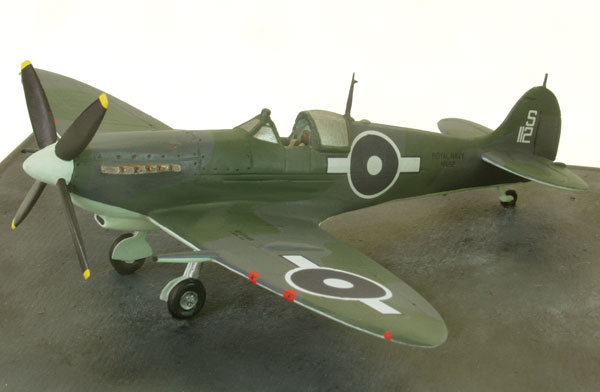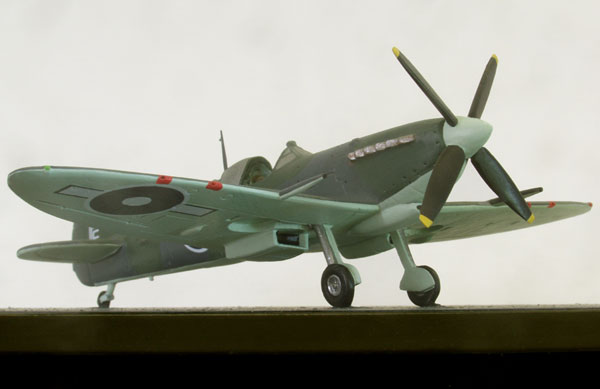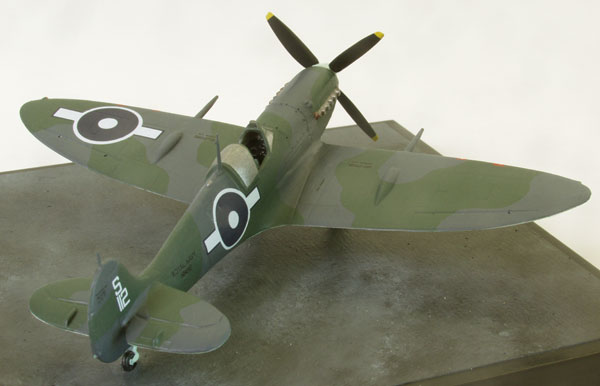Supermarine Seafire Mk LIII
Supermarine Seafire Mk LIII NN212 112/S 887 Naval Air Squadron
HMS Indefatigable Sub/Lt G J Murphy off Japan, August 1950
Before the end of 1939 Supermarine had offered the Admiralty a “navalised” Spitfire, but this was declined by Their Lordships, specifically it has been said by the First Lord of the Admiralty. Interest was re-ignited in the New Year, possibly influenced by the successful landing of Hurricanes on the carrier Glorious by No.46 Squadron RAF as part of the withdrawal from operations in Norway, flown by relatively inexperienced pilots with no training in deck-landing.
The Navy received some early Spitfires for training in 1941, while the Seafire was being developed from the Spitfire V, with incremental addition of naval equipment. All were powered by the Merlin; based on the Spitfire Vb the Seafire Ib had a three-bladed propeller and an A-frame arrestor hook with two 20mm cannon and four .303 machine guns, twelve Seafire Ibs of 801 NAS taking part in Operation Torch flying from HMS Furious. By this time the Seafire IIc was also in front line service; this, based on the Spitfire Vc, was the first mark built from the start as a naval aircraft with additional catapult spools, and strengthening plates on the fuselage. The later production aircraft were designated L IIc, with four-bladed propellers and the engined optimised for lower level combat. The Mk III had manually-folded wings, with small folding tips enabling it to fit in the hangars of Royal Navy aircraft carriers; the engine was the Merlin 55, with the Merlin 55M in the L.III also giving better low-level performance. The III and the L III served side by side on carriers to give a greater spread of defensive cover, with the L.III intended particularly in the Eastern fleets as counter to the very low level kamikaze attacks. With Supermarine committed to Spitfire development and production for the RAF the task of producing Fleet Air Arm’s Seafire variant was largely in the hands of Westland Aircraft – from whom came NN212 – and their subsidiary Cunliffe-Owen Aircraft, between them building over 1,100 IIIs and L IIIs, the greatest run of any Seafire mark.
The British Pacific Fleet was established in November 1944, initially with three aircraft carriers (though three more would join later); its purpose was to serve alongside the U S Navy in the Central Pacific, working toward the assault on the Japanese homeland. In its initial form the forty Seafires of 887 and 894 Naval Air Squadrons formed more than a quarter of its air strength, tasked with the air defence of the fleet; heavier fighters, Hellcats and Corsairs, were to be used with their longer range for more directly offensive sorties.
The fleet sailed from Sydney on 10 March, 1945, becoming Task Force 57; although not at full strength in either personnel or material for its air operations, it took part in Operation Iceberg, the invasion of Okinawa. By now the proportion of Seafire L.IIIs to the standard Mark IIIs had been increased against the likelihood of kamikaze attacks. At the end of May the Task Force returned to Australia, where they were joined by HMS Implacable, carrying 801 and 880 Naval Air Squadrons. To meet the need to extend the Seafires’ endurance, 24 Naval Fighter Wing used the standard 90 gallon “slipper” tank, but 38 NFW experimented successfully with the 89 gallon tank normally used on USAAF P-40s and with these proving very satisfactory enough were “acquired” to equip all the wing’s forty-eight aircraft.
The BPF sailed north to rejoin the USN for what would be the final round of strikes against Japan, and by the middle of August were stationed fifty miles south-east of Yokohama. With USN Task Force 38 was near the mainland awaiting news of the possible surrender they were joined by HMS King George V and HMS Indefatigable, (as Task Force 38.5). From 13 to 15 August Indefatigable’s air wing attacked targets in the Tokyo area; at 0400 on 15th the carrier’s Fireflies launched on a Ramrod sweep, followed by Avengers and escorted by eight Seafires from 887 and 894 NAS. Five, led by Sub Lt. F Hockley were to give cover at lower and middle levels, with three led by Sub Lt. V Lowden providing top cover. The original target, Kisarazu airfield, was obscured by cloud so the Avengers switched to their alternate target, a chemical factory near Odaki Bay. Crossing Tokyo Bay the Seafires ignored a pair of Zeros at low level suspecting them to be a decoy, but shortly afterwards a dozen Zeros dived from three o’clock high, passing the Seafires and heading for the Avengers, but shooting down Sub Lt. Hockley who, executed by his Japanese captors, was to be the last Royal Navy casualty of the war.
Sub Lt. Lowden, turning his flight to meet the second wave of Zeros, opened fire at long range and hit a Zero, resulting in the dropping of its undercarriage; his no.2, Sub.Lt. “Taffy” Williams scored hits on a Zero, for which he was credited with a shared kill, and Sub.Lt. Lowden’s next burst caused his target to explode in mid-air. The third pilot in this flight, Sub Lt. “Spud” Murphy, flying NN212, scoring hits on one Zero and then turning his fire on a second, hitting its underside and engine resulting in flames and a lowering undercarriage; he then closed on a third, holding his fire until 100 yards off and then hitting its engine and cockpit area. These were the last two FAA kills of the conflict. All the Avengers hit their target and returned to Indefatigable, though one was so badly damaged that it had to be ditched alongside a destroyer. Operations were suspended from the following morning, and these were the last dogfights of the war; and “Spud” Murphy’s two kills were the last in British service by R J Mitchell’s legendary fighter, a tally that had started over Scotland in October 1939.
The British Pacific Fleet was run down quickly after the end of hostilities, some of its units very quickly indeed. 887 Naval Air Squadron was one of several “Hostilities Only” units. Formed initially with Fulmars in May 1942 at Lee on Solent, its operational career was all with the Seafire; in the summer of 1944 it was based on Indefatigable in operations against the Tirpitz in its Norwegian fjord, leaving to join the British Pacific Fleet in November. Spending some time in the Antipodes after the end of the war, 887 returned to the UK with Indefatigable and disbanded at Gosport in March, 1946.
Scale 1:72 Wingspan 6.25″ (156 mm)
Base size 6.37″ (162 mm) square (No. 4)
Weight not including base 6.75 ozs (190 grams) Limited edition of 25 only




